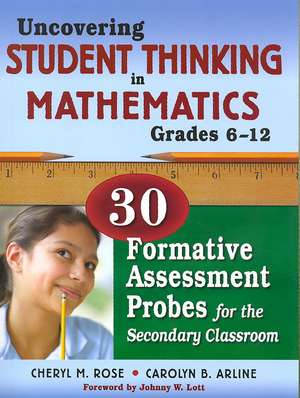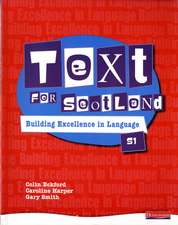Uncovering Student Thinking in Mathematics, Grades 6-12: 30 Formative Assessment Probes for the Secondary Classroom
Editat de Cheryl Rose Tobey, Carolyn B. Arlineen Limba Engleză Paperback – 18 aug 2008
| Toate formatele și edițiile | Preț | Express |
|---|---|---|
| Paperback (1) | 326.35 lei 6-8 săpt. | |
| SAGE Publications – 18 aug 2008 | 326.35 lei 6-8 săpt. | |
| Hardback (1) | 578.79 lei 6-8 săpt. | |
| SAGE Publications – 3 sep 2008 | 578.79 lei 6-8 săpt. |
Preț: 326.35 lei
Nou
Puncte Express: 490
Preț estimativ în valută:
62.45€ • 66.78$ • 52.07£
62.45€ • 66.78$ • 52.07£
Carte tipărită la comandă
Livrare economică 17 aprilie-01 mai
Preluare comenzi: 021 569.72.76
Specificații
ISBN-13: 9781412963770
ISBN-10: 141296377X
Pagini: 248
Dimensiuni: 216 x 279 x 16 mm
Greutate: 0.69 kg
Ediția:1
Editura: SAGE Publications
Colecția Corwin
Locul publicării:Thousand Oaks, United States
ISBN-10: 141296377X
Pagini: 248
Dimensiuni: 216 x 279 x 16 mm
Greutate: 0.69 kg
Ediția:1
Editura: SAGE Publications
Colecția Corwin
Locul publicării:Thousand Oaks, United States
Recenzii
"Cheryl Rose and Carolyn Arline provide a valuable resource to teachers who are interested in determining how their students think and answer questions in mathematics classes."
"The authors contribute to the field by answering the question: How do I help my struggling students who hold a variety of misconceptions or have limited prior knowledge of the content?"
"The book is timely. The probes will be beneficial to teachers and very useful to districts developing local assessments."
"An efficient teaching tool to uncover and correct misconceptions students have across all mathematics strands. This book provides numerous opportunities for increased student achievement that are both powerful and exciting for educators."
"A tool for middle school and high school mathematics teachers that combines the effective use of research, formative assessment, and ready-to-go student tasks. This resource belongs int he hands of any mathematics educator who seeks to balance procedural knowledge, conceptual understanding, and skills for each student."
"Using probes with my students has helped me plan and modify my instruction. The range of student explanations elicit rich mathematical discourse."
"One of the most effective tools for teachers to gather valuable formative assessment data. This resource provides an easily accessible, yet powerful way for teachers to elicit and analyze student work that truly reflects student thinking. The probes are targeted to specific concept areas that are easily connected to daily lesson plans and curriculum materials."
"The authors contribute to the field by answering the question: How do I help my struggling students who hold a variety of misconceptions or have limited prior knowledge of the content?"
"The book is timely. The probes will be beneficial to teachers and very useful to districts developing local assessments."
"An efficient teaching tool to uncover and correct misconceptions students have across all mathematics strands. This book provides numerous opportunities for increased student achievement that are both powerful and exciting for educators."
"A tool for middle school and high school mathematics teachers that combines the effective use of research, formative assessment, and ready-to-go student tasks. This resource belongs int he hands of any mathematics educator who seeks to balance procedural knowledge, conceptual understanding, and skills for each student."
"Using probes with my students has helped me plan and modify my instruction. The range of student explanations elicit rich mathematical discourse."
"One of the most effective tools for teachers to gather valuable formative assessment data. This resource provides an easily accessible, yet powerful way for teachers to elicit and analyze student work that truly reflects student thinking. The probes are targeted to specific concept areas that are easily connected to daily lesson plans and curriculum materials."
Cuprins
Foreword by Johnny W. Lott
Preface
Acknowledgments
About the Authors
1. Mathematics Assessment Probes
Introduction
What Types of Understandings and Misunderstandings Does a Mathematics Assessment Probe Uncover?
How Were the Mathematics Assessment Probes Developed?
What Is the Structure of a Mathematics Assessment Probe?
What Additional Information Is Provided With Each Mathematics Assessment Probe?
What Mathematics Assessment Probes Are Included in the Book?
2. Instructional Implications
Differentiating Instruction
Assessing Points of Entry
Analyzing Trends in Student Thinking
Giving Student Interviews
Promoting Student-to-Student Dialogue
Developing Vocabulary
Allowing for Individual Think Time
Improving Students' Process Skills
Assessing Effectiveness of Instructional Activities
Moving Beyond the Individual Classroom
Summary
3. Number and Operations Assessment Probes
Probe 1: What Is the Value of the Digit?
Teachers' Notes: What Is the Value of the Digit?
Probe 1a: What Is the Value of the Digit? Variation
Probe 2: What Is the Meaning of 2/3?
Teachers' Notes: What Is the Meaning of 2/3?
Probe 2a: What Is the Meaning of 2/3? Variation
Probe 3: Is It Equivalent?
Teachers' Notes: Is It Equivalent?
Probe 3a: Is It Equivalent? Variation
Probe 4: What's Your Estimate?
Teachers' Notes: What's Your Estimate?
Probe 5: Is It an Estimate?
Teachers' Notes: Is It an Estimate?
Probe 6: Is It Simplified?
Teachers' Notes: Is It Simplified?
Probe 6a: Is It Simplified? Algebraic Variation
Probe 7: Where Is a Million?
Teachers' Notes: Where Is a Million?
Probe 8: How Low Can You Go?
Teachers’ Notes: How Low Can You Go?
Probe 8a: How Low Can You Go? Variation
Probe 9: What’s Your Addition Strategy?
Teachers’ Notes: What’s Your Addition Strategy?
Probe 9a: What’s Your Addition Strategy? Decimals Variation
Probe 9b: What’s Your Addition Strategy? Fractions Variation
Probe 10: What’s Your Subtraction Strategy?
Teachers’ Notes: What’s Your Subtraction Strategy?
Probe 10a: What’s Your Subtraction Strategy? Decimals Variation
Probe 10b: What’s Your Subtraction Strategy? Fractions Variation
Probe 11: What’s Your Multiplication Strategy?
Teachers’ Notes: What’s Your Multiplication Strategy?
Probe 11a: What’s Your Multiplication Strategy? Decimals Variation
Probe 12: What’s Your Division Strategy?
Teachers’ Notes: What’s Your Division Strategy?
Probe 12a: What’s Your Division Strategy? Decimals Variation
4. Geometry, Measurement, and Data Assessment Probes
Probe 1: What’s the Measure?
Teachers’ Notes: What’s the Measure?
Probe 1a: What’s the Measure? Variation
Probe 2: Are Area and Perimeter Related?
Teachers’ Notes: Are Area and Perimeter Related?
Probe 3: What’s the Area?
Teachers’ Notes: What’s the Area?
Probe 4: What’s the Capacity?
Teachers’ Notes: What’s the Capacity?
Probe 5: Is It Transformed?
Teachers’ Notes: Is It Transformed?
Probe 6: Are They Similar?
Teachers’ Notes: Are They Similar?
Probe 7: What Do You Mean?
Teachers’ Notes: What Do You Mean?
Probe 7a: What Do You Mean? Variation
Probe 8: Name of the Graph?
Teachers’ Notes: Name of the Graph?
Probe 9: Graph Construction?
Teachers’ Notes: Graph Construction?
5. Algebra and Data Assessment Probes
Probe 1: Equal or Not Equal?
Teachers’ Notes: Equal or Not Equal?
Probe 2: Is It the Same as a+b?
Teachers’ Notes: Is It the Same as a+b?
Probe 3: M & N’s?
Teachers’ Notes: M & N’s?
Probe 4: What’s the Substitute?
Teachers’ Notes: What’s the Substitute?
Probe 5: Is It True?
Teachers’ Notes: Is It True?
Probe 6: Solving Equations?
Teachers’ Notes: Solving Equations?
Probe 7: Correct Representation of the Inequality?
Teachers’ Notes: Correct Representation of the Inequality?
Probe 8: Is It a Variable?
Teachers’ Notes: Is It a Variable?
Probe 9: Binomial Expansion?
Teachers’ Notes: Binomial Expansion?
Probe 10: Is It Quadratic?
Teachers’ Notes: Is It Quadratic?
Resource A: Note Template for QUEST Cycle
References
Index
Preface
Acknowledgments
About the Authors
1. Mathematics Assessment Probes
Introduction
What Types of Understandings and Misunderstandings Does a Mathematics Assessment Probe Uncover?
How Were the Mathematics Assessment Probes Developed?
What Is the Structure of a Mathematics Assessment Probe?
What Additional Information Is Provided With Each Mathematics Assessment Probe?
What Mathematics Assessment Probes Are Included in the Book?
2. Instructional Implications
Differentiating Instruction
Assessing Points of Entry
Analyzing Trends in Student Thinking
Giving Student Interviews
Promoting Student-to-Student Dialogue
Developing Vocabulary
Allowing for Individual Think Time
Improving Students' Process Skills
Assessing Effectiveness of Instructional Activities
Moving Beyond the Individual Classroom
Summary
3. Number and Operations Assessment Probes
Probe 1: What Is the Value of the Digit?
Teachers' Notes: What Is the Value of the Digit?
Probe 1a: What Is the Value of the Digit? Variation
Probe 2: What Is the Meaning of 2/3?
Teachers' Notes: What Is the Meaning of 2/3?
Probe 2a: What Is the Meaning of 2/3? Variation
Probe 3: Is It Equivalent?
Teachers' Notes: Is It Equivalent?
Probe 3a: Is It Equivalent? Variation
Probe 4: What's Your Estimate?
Teachers' Notes: What's Your Estimate?
Probe 5: Is It an Estimate?
Teachers' Notes: Is It an Estimate?
Probe 6: Is It Simplified?
Teachers' Notes: Is It Simplified?
Probe 6a: Is It Simplified? Algebraic Variation
Probe 7: Where Is a Million?
Teachers' Notes: Where Is a Million?
Probe 8: How Low Can You Go?
Teachers’ Notes: How Low Can You Go?
Probe 8a: How Low Can You Go? Variation
Probe 9: What’s Your Addition Strategy?
Teachers’ Notes: What’s Your Addition Strategy?
Probe 9a: What’s Your Addition Strategy? Decimals Variation
Probe 9b: What’s Your Addition Strategy? Fractions Variation
Probe 10: What’s Your Subtraction Strategy?
Teachers’ Notes: What’s Your Subtraction Strategy?
Probe 10a: What’s Your Subtraction Strategy? Decimals Variation
Probe 10b: What’s Your Subtraction Strategy? Fractions Variation
Probe 11: What’s Your Multiplication Strategy?
Teachers’ Notes: What’s Your Multiplication Strategy?
Probe 11a: What’s Your Multiplication Strategy? Decimals Variation
Probe 12: What’s Your Division Strategy?
Teachers’ Notes: What’s Your Division Strategy?
Probe 12a: What’s Your Division Strategy? Decimals Variation
4. Geometry, Measurement, and Data Assessment Probes
Probe 1: What’s the Measure?
Teachers’ Notes: What’s the Measure?
Probe 1a: What’s the Measure? Variation
Probe 2: Are Area and Perimeter Related?
Teachers’ Notes: Are Area and Perimeter Related?
Probe 3: What’s the Area?
Teachers’ Notes: What’s the Area?
Probe 4: What’s the Capacity?
Teachers’ Notes: What’s the Capacity?
Probe 5: Is It Transformed?
Teachers’ Notes: Is It Transformed?
Probe 6: Are They Similar?
Teachers’ Notes: Are They Similar?
Probe 7: What Do You Mean?
Teachers’ Notes: What Do You Mean?
Probe 7a: What Do You Mean? Variation
Probe 8: Name of the Graph?
Teachers’ Notes: Name of the Graph?
Probe 9: Graph Construction?
Teachers’ Notes: Graph Construction?
5. Algebra and Data Assessment Probes
Probe 1: Equal or Not Equal?
Teachers’ Notes: Equal or Not Equal?
Probe 2: Is It the Same as a+b?
Teachers’ Notes: Is It the Same as a+b?
Probe 3: M & N’s?
Teachers’ Notes: M & N’s?
Probe 4: What’s the Substitute?
Teachers’ Notes: What’s the Substitute?
Probe 5: Is It True?
Teachers’ Notes: Is It True?
Probe 6: Solving Equations?
Teachers’ Notes: Solving Equations?
Probe 7: Correct Representation of the Inequality?
Teachers’ Notes: Correct Representation of the Inequality?
Probe 8: Is It a Variable?
Teachers’ Notes: Is It a Variable?
Probe 9: Binomial Expansion?
Teachers’ Notes: Binomial Expansion?
Probe 10: Is It Quadratic?
Teachers’ Notes: Is It Quadratic?
Resource A: Note Template for QUEST Cycle
References
Index
Descriere
Discussing standards, research, and more, these 30 probes help secondary teachers assess students' grasp of core mathematics concepts and modify their instruction to improve student achievement.









